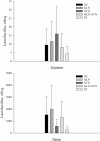Replacing dietary antibiotics with 0.20% l-glutamine and synbiotics following weaning and transport in pigs
- PMID: 32841327
- PMCID: PMC7507408
- DOI: 10.1093/jas/skaa272
Replacing dietary antibiotics with 0.20% l-glutamine and synbiotics following weaning and transport in pigs
Erratum in
-
Correction to: Replacing dietary antibiotics with 0.20% L-glutamine and synbiotics following weaning and transport in pigs.J Anim Sci. 2023 Jan 3;101:skad025. doi: 10.1093/jas/skad025. J Anim Sci. 2023. PMID: 36680525 Free PMC article. No abstract available.
Abstract
Dietary antibiotic use has been limited in swine production due to concerns regarding antibiotic resistance. However, this may negatively impact the health, productivity, and welfare of pigs. Therefore, the study objective was to determine if combining dietary synbiotics and 0.20% l-glutamine would improve pig growth performance and intestinal health following weaning and transport when compared with traditionally used dietary antibiotics. Because previous research indicates that l-glutamine improves swine growth performance and synbiotics reduce enterogenic bacteria, it was hypothesized that supplementing diets with 0.20% l-glutamine (GLN) and synbiotics (SYN; 3 strains of Lactobacillus [1.2 × 10^9 cfu/g of strain/pig/d] + β-glucan [0.01 g/pig/d] + fructooligosaccharide [0.01 g/pig/d]) would have an additive effect and improve pig performance and intestinal health over that of dietary antibiotics. Mixed-sex pigs (N = 226; 5.86 ± 0.11 kg body weight [BW]) were weaned (19.4 ± 0.2 d of age) and transported for 12 h in central Indiana. Pigs were blocked by BW and allotted to one of two dietary treatments (5 to 6 pigs per pen): antibiotics (positive control [PC]; chlortetracycline [441 ppm] + tiamulin [38.5 ppm]), no antibiotics (negative control [NC]), GLN, SYN, or the NC diet with both the GLN and SYN additives (GLN + SYN) fed for 14 d. From day 14 post-weaning to the end of the grow-finish period, all pigs were provided common antibiotic-free diets. Data were analyzed using PROC GLIMMIX and PROC MIXED in SAS 9.4. Overall, haptoglobin was greater (P = 0.03; 216%) in NC pigs compared with PC pigs. On day 13, GLN and PC pigs tended to have reduced (P = 0.07; 75.2% and 67.3%, respectively) haptoglobin compared with NC pigs. On day 34, the jejunal goblet cell count per villi and per millimeter tended to be greater (P < 0.08; 71.4% and 62.9%, respectively) in SYN pigs compared with all other dietary treatments. Overall, jejunal mucosa tumor necrosis factor-alpha (TNFα) gene expression tended to be greater (P = 0.09; 40.0%) in NC pigs compared with PC pigs on day 34. On day 34, jejunal mucosa TNFα gene expression tended to be greater (P = 0.09; 33.3%, 41.2%, and 60.0%, respectively) in GLN pigs compared with SYN, GLN + SYN, and PC pigs. Although it was determined that some metrics of pig health were improved by the addition of GLN and SYN (i.e., haptoglobin and goblet cell count), overall, there were very few differences detected between dietary treatments and this may be related to the stress load incurred by the pigs.
Keywords: L-glutamine; antibiotics; pigs; synbiotics; transport; weaning.
Published by Oxford University Press on behalf of the American Society of Animal Science 2020.
Figures



References
-
- Brooks P H, Moran C A, Beal J D, Demeckova V, and Campbell A.. 2001. Liquid feeding for the young piglet. In: Varley M A, and Wiseman J, editors. The weaner pig: nutrition and management. Wallingford: CABI Publishing; p. 153–178.
-
- Cook R D. 1977. Detection of influential observations in linear regression. Technometrics 19:15–18. doi:10.1080/00401706.1977.10489493 - DOI
MeSH terms
Substances
LinkOut - more resources
Full Text Sources
Medical
Miscellaneous

